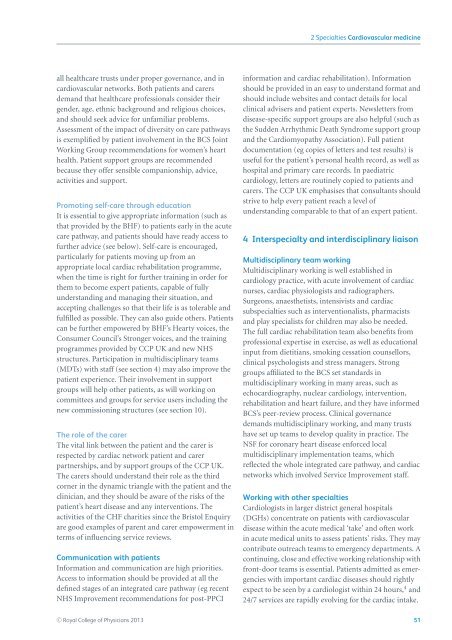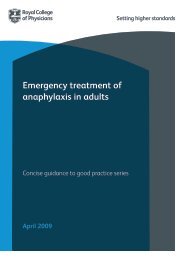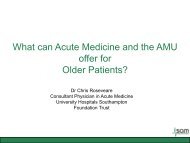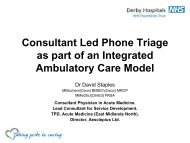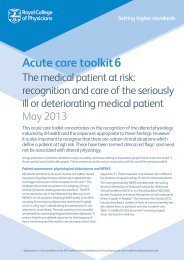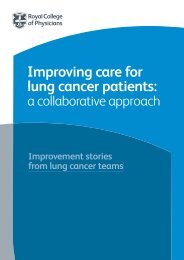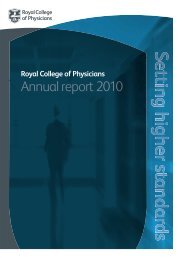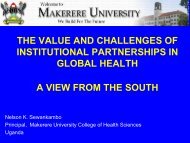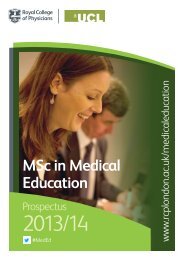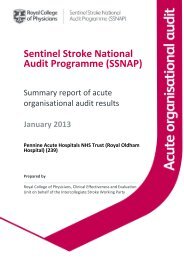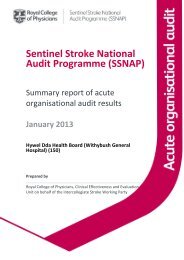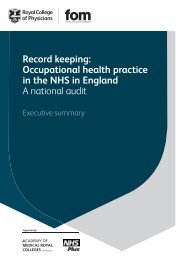Consultant physicians working with patients - Royal College of ...
Consultant physicians working with patients - Royal College of ...
Consultant physicians working with patients - Royal College of ...
You also want an ePaper? Increase the reach of your titles
YUMPU automatically turns print PDFs into web optimized ePapers that Google loves.
2 Specialties Cardiovascular medicineall healthcare trusts under proper governance, and incardiovascular networks. Both <strong>patients</strong> and carersdemand that healthcare pr<strong>of</strong>essionals consider theirgender, age, ethnic background and religious choices,and should seek advice for unfamiliar problems.Assessment <strong>of</strong> the impact <strong>of</strong> diversity on care pathwaysis exemplified by patient involvement in the BCS JointWorking Group recommendations for women’s hearthealth. Patient support groups are recommendedbecause they <strong>of</strong>fer sensible companionship, advice,activities and support.Promoting self-care through educationIt is essential to give appropriate information (such asthat provided by the BHF) to <strong>patients</strong> early in the acutecare pathway, and <strong>patients</strong> should have ready access t<strong>of</strong>urther advice (see below). Self-care is encouraged,particularly for <strong>patients</strong> moving up from anappropriate local cardiac rehabilitation programme,when the time is right for further training in order forthem to become expert <strong>patients</strong>, capable <strong>of</strong> fullyunderstanding and managing their situation, andaccepting challenges so that their life is as tolerable andfulfilled as possible. They can also guide others. Patientscan be further empowered by BHF’s Hearty voices, theConsumer Council’s Stronger voices, and the trainingprogrammes provided by CCP UK and new NHSstructures. Participation in multidisciplinary teams(MDTs) <strong>with</strong> staff (see section 4) may also improve thepatient experience. Their involvement in supportgroups will help other <strong>patients</strong>, as will <strong>working</strong> oncommittees and groups for service users including thenew commissioning structures (see section 10).The role <strong>of</strong> the carerThe vital link between the patient and the carer isrespected by cardiac network patient and carerpartnerships, and by support groups <strong>of</strong> the CCP UK.The carers should understand their role as the thirdcorner in the dynamic triangle <strong>with</strong> the patient and theclinician, and they should be aware <strong>of</strong> the risks <strong>of</strong> thepatient’s heart disease and any interventions. Theactivities <strong>of</strong> the CHF charities since the Bristol Enquiryare good examples <strong>of</strong> parent and carer empowerment interms <strong>of</strong> influencing service reviews.Communication <strong>with</strong> <strong>patients</strong>Information and communication are high priorities.Access to information should be provided at all thedefined stages <strong>of</strong> an integrated care pathway (eg recentNHS Improvement recommendations for post-PPCIinformation and cardiac rehabilitation). Informationshould be provided in an easy to understand format andshould include websites and contact details for localclinical advisers and patient experts. Newsletters fromdisease-specific support groups are also helpful (such asthe Sudden Arrhythmic Death Syndrome support groupand the Cardiomyopathy Association). Full patientdocumentation (eg copies <strong>of</strong> letters and test results) isuseful for the patient’s personal health record, as well ashospital and primary care records. In paediatriccardiology, letters are routinely copied to <strong>patients</strong> andcarers. The CCP UK emphasises that consultants shouldstrive to help every patient reach a level <strong>of</strong>understanding comparable to that <strong>of</strong> an expert patient.4 Interspecialty and interdisciplinary liaisonMultidisciplinary team <strong>working</strong>Multidisciplinary <strong>working</strong> is well established incardiology practice, <strong>with</strong> acute involvement <strong>of</strong> cardiacnurses, cardiac physiologists and radiographers.Surgeons, anaesthetists, intensivists and cardiacsubspecialties such as interventionalists, pharmacistsand play specialists for children may also be needed.The full cardiac rehabilitation team also benefits frompr<strong>of</strong>essional expertise in exercise, as well as educationalinput from dietitians, smoking cessation counsellors,clinical psychologists and stress managers. Stronggroups affiliated to the BCS set standards inmultidisciplinary <strong>working</strong> in many areas, such asechocardiography, nuclear cardiology, intervention,rehabilitation and heart failure, and they have informedBCS’s peer-review process. Clinical governancedemands multidisciplinary <strong>working</strong>, and many trustshave set up teams to develop quality in practice. TheNSF for coronary heart disease enforced localmultidisciplinary implementation teams, whichreflected the whole integrated care pathway, and cardiacnetworks which involved Service Improvement staff.Working <strong>with</strong> other specialtiesCardiologists in larger district general hospitals(DGHs) concentrate on <strong>patients</strong> <strong>with</strong> cardiovasculardisease <strong>with</strong>in the acute medical ‘take’ and <strong>of</strong>ten workin acute medical units to assess <strong>patients</strong>’ risks. They maycontribute outreach teams to emergency departments. Acontinuing, close and effective <strong>working</strong> relationship <strong>with</strong>front-door teams is essential. Patients admitted as emergencies<strong>with</strong> important cardiac diseases should rightlyexpect to be seen by a cardiologist <strong>with</strong>in 24 hours, 4 and24/7 services are rapidly evolving for the cardiac intake.C○ <strong>Royal</strong> <strong>College</strong> <strong>of</strong> Physicians 2013 51


